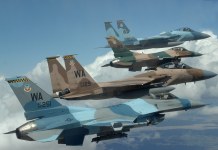Tensions between the United States and China have increased considerably in the aftermath of Nancy Pelosi’s visit to Taiwan earlier in August, prompting Beijing to conduct major maneuvers with its warships and military aircraft.
According to Taiwan News, which cited radio transmissions, US military helicopters breached China’s “territorial airspace” on August 28 and 29. The Chinese warplane pilot warned the US military aircraft in Mandarin and English.
All the broadcasts were detected and documented by the military enthusiast’s Facebook page Taiwan ADIZ. Taiwan ADIZ claims that on August 28 and August 29, Chinese fighters intercepted American military aircraft, and the latter finally left Chinese airspace.
According to a representative of Taiwan ADIZ, the US Navy’s Sikorsky MH-60 Seahawk helicopter on August 28 crossed the 12-nautical-mile line separating China’s territorial sea from Taiwan.
The US military aircraft approaching China’s east coast from the Taiwan Strait at 8:14 a.m. reportedly heard radio transmissions saying, “I am the Chinese Air Force, you are approaching my airspace, leave immediately, or I will intercept.”
At 8:38 a.m, the American aircraft’s pilot could be heard saying: “I am a United States military aircraft conducting lawful military activities in international airspace and exercising these rights as guaranteed by international law. I am operating with due regard to the rights and duties of all states.”

Both pilots reiterated the same message over the next hour. “This is the Chinese PLA Air Force; you have entered China’s territorial airspace, a serious violation of China’s sovereignty; leave immediately, leave immediately!” said the PLA Air Force announcer at 10:32 a.m. in Mandarin and English.
The PLA was again overhead around 10 a.m. on August 29, advising a US military plane that it was nearing Chinese territory and should leave immediately. The US plane proceeded on its course even after being warned that it had crossed “China’s territorial airspace” and that it needed to leave immediately.
The MH-60 Seahawk helicopters are most likely from the Ticonderoga-class guided-missile cruisers, the USS Antietam (CG 54) and USS Chancellorsville (CG 62). On August 28, these two warships entered the Taiwan Strait. Both ships have two Sikorsky SH-60B or MH-60R Seahawk LAMPS III helicopters.
Taiwan Navy Exchanges Warnings
Meanwhile, Taiwanese media reports that radio interactions with Chinese military ships have become routine.
Li Kuang-ping, the captain of the Taiwan Navy’s Cheng Kung-class ship Chang Chien, said he frequently communicates with Chinese Navy ships over the radio while on missions to monitor ships at sea, with both sides issuing warnings to avoid each other, according to CNA.
“Even though we know each other’s position, we cannot agree with each other,” he said. The captain continued by saying that occasionally, even small Chinese fishing boats would ask for the Chinese military ship to strike first and skip any dialogue. He said that the Navy chooses to ignore messages of this nature.
On August 30, President Tsai Ing-wen visited Penghu to inspect the Tien Chu Air Force unit, the Penghu Defense Command’s air defense company, the Air Force’s Seventh Radar Squadron, and the Navy’s 146th Fleet and to offer words of encouragement to them in the face of escalating Chinese military activities near Taiwan.

The island nation also has to deal with ongoing drone incursions from China. On August 31, three Chinese drones intruded over three islands in Kinmen County, forcing Taiwan’s military to use live ammunition against UAVs for the second day.
At 8:40 that night, the Army’s Kinmen Defense Command (KDC) stated that three “civilian” Chinese drones had violated the airspace above the Lieyu, Dadan, and Caoyu islands. To fend off the UAVs, Taiwanese soldiers retaliated by firing live rounds and signal flares.
According to the KDC, the drones quickly moved away in the direction of Xiamen, China. The command announced that it would uphold alertness and continuously monitor the situation.
Similarly, at 5:59 p.m. on August 30, another drone breached the restricted airspace over Erdan Island, defied warnings from Taiwanese forces, and flew toward Xiamen in a minute. The clash on Tuesday was the first time Kinmen troops used live rounds against Chinese drones.
- Contact the author at ashishmichel@gmail.com
- Follow EurAsian Times on Google News




